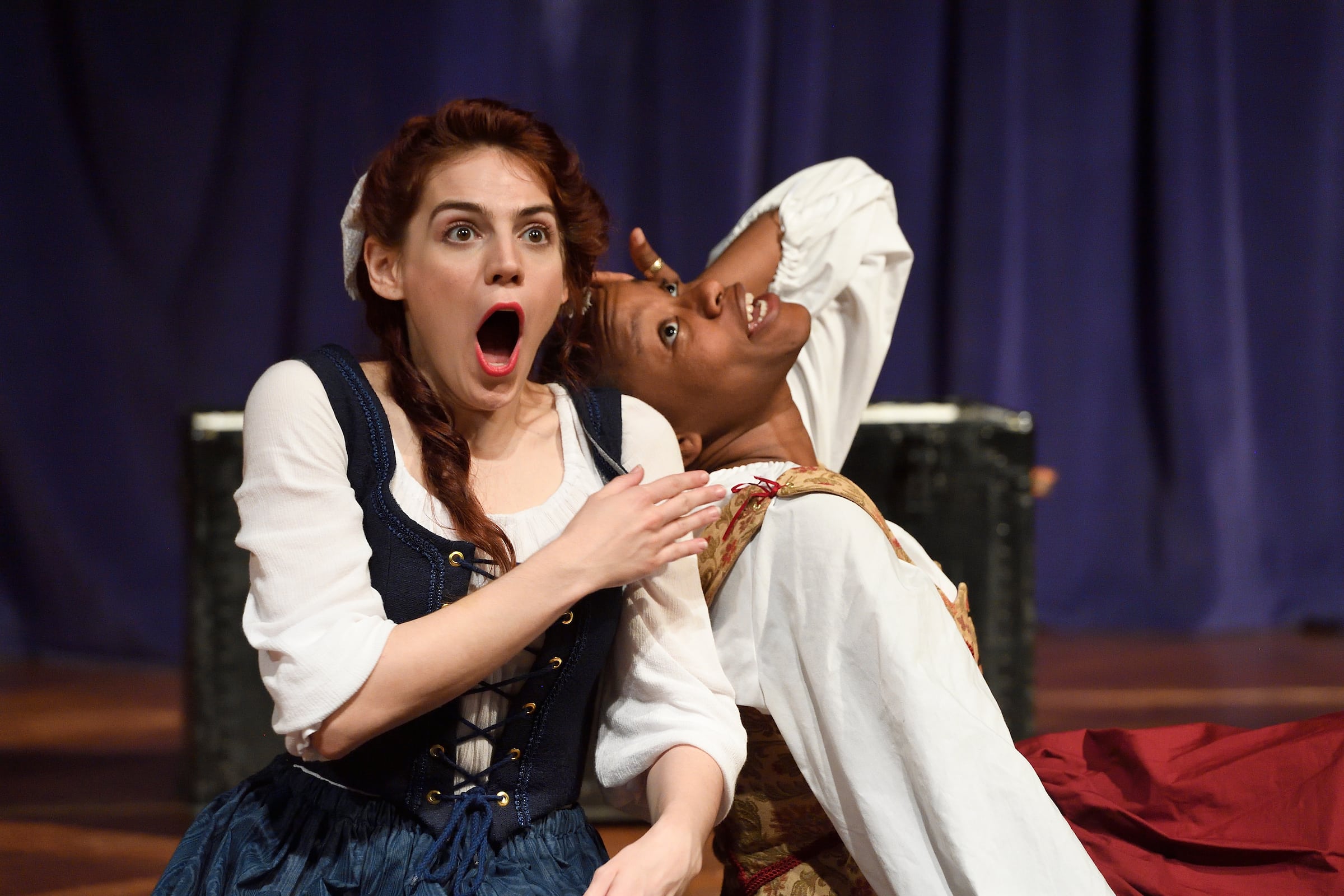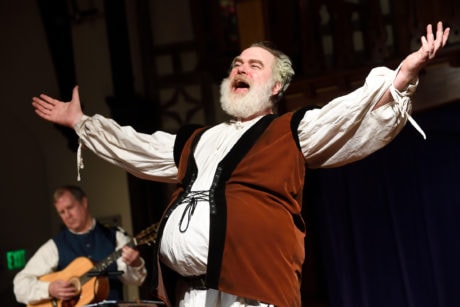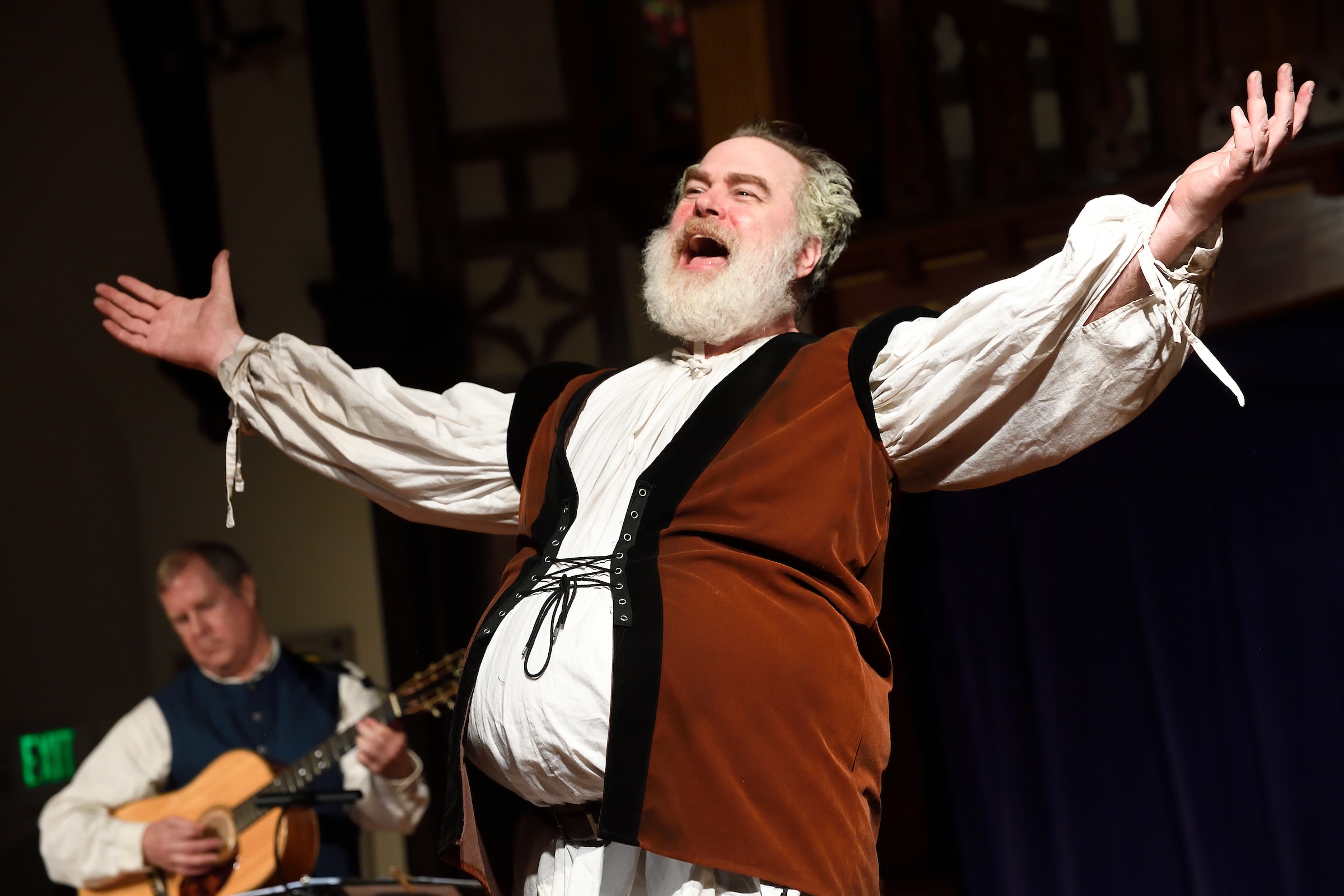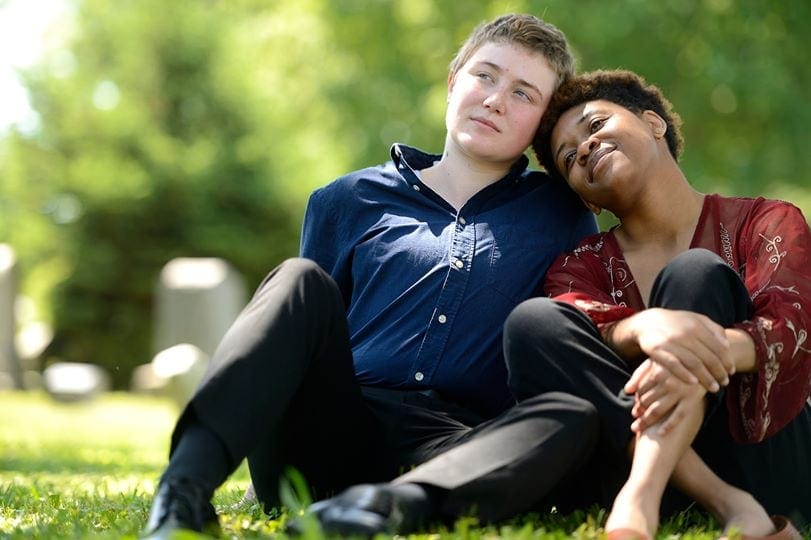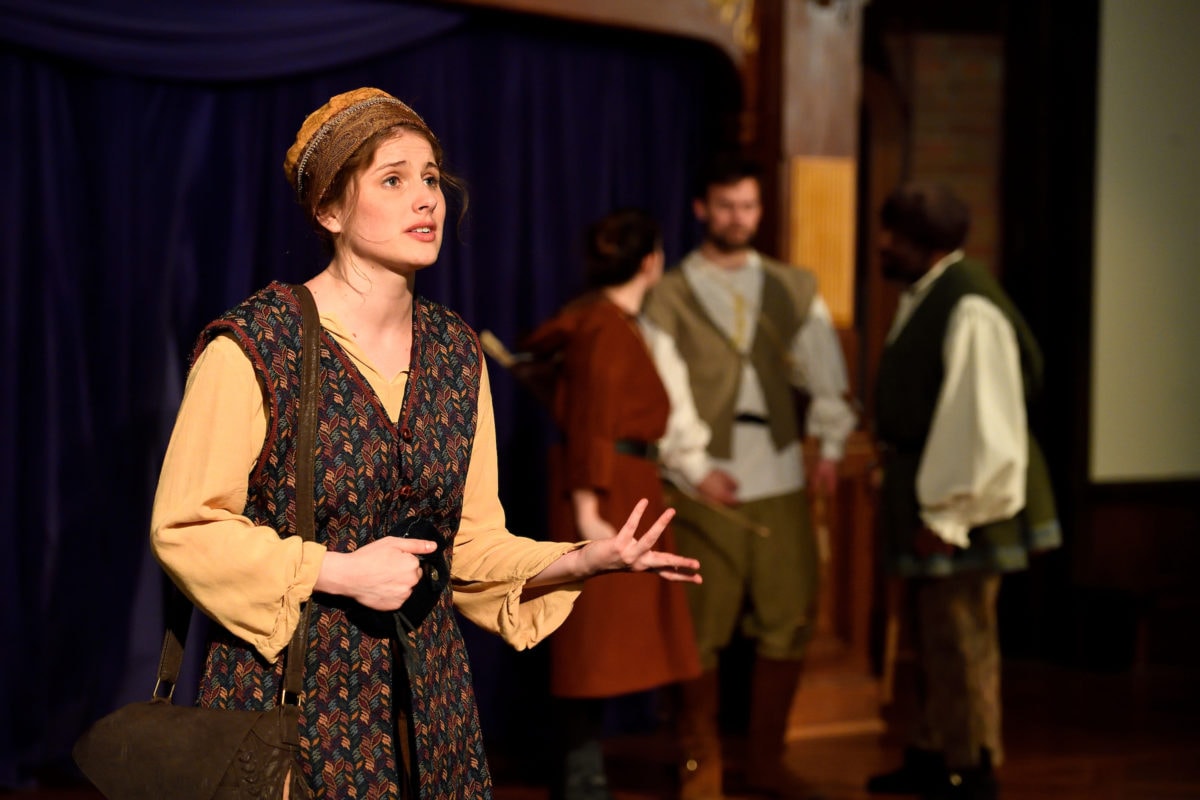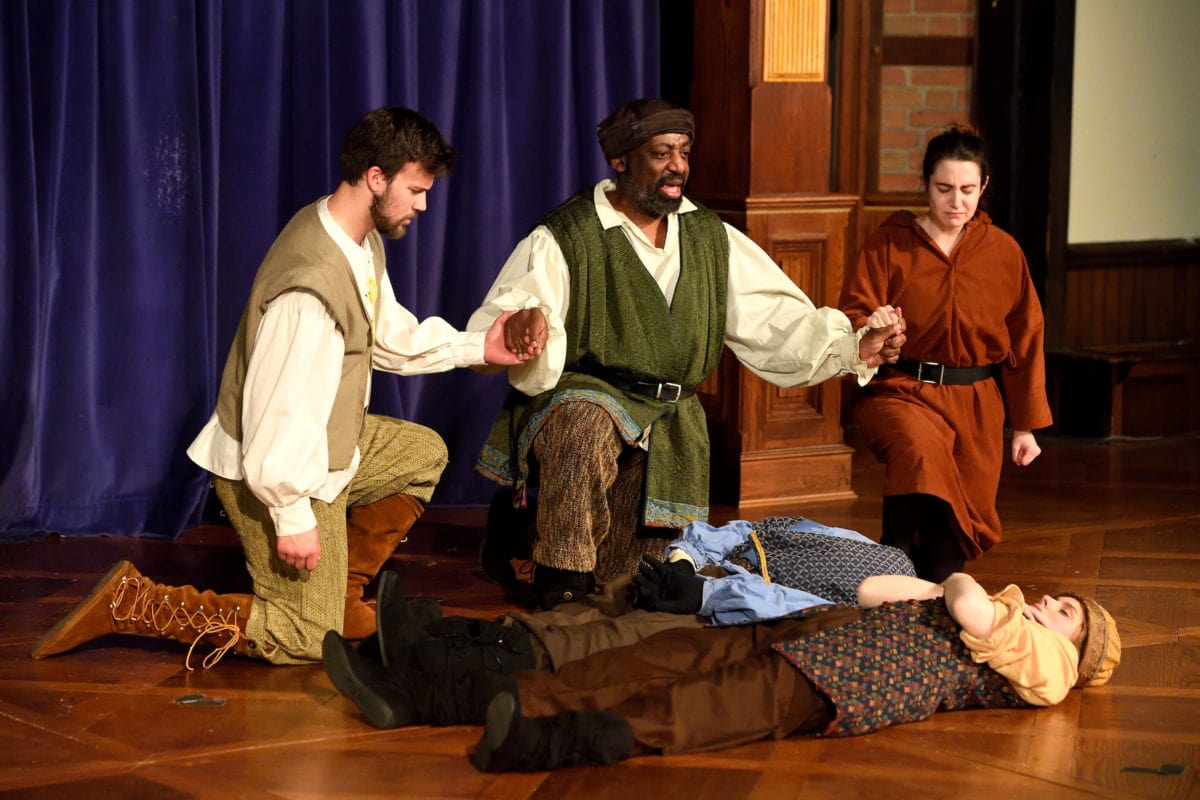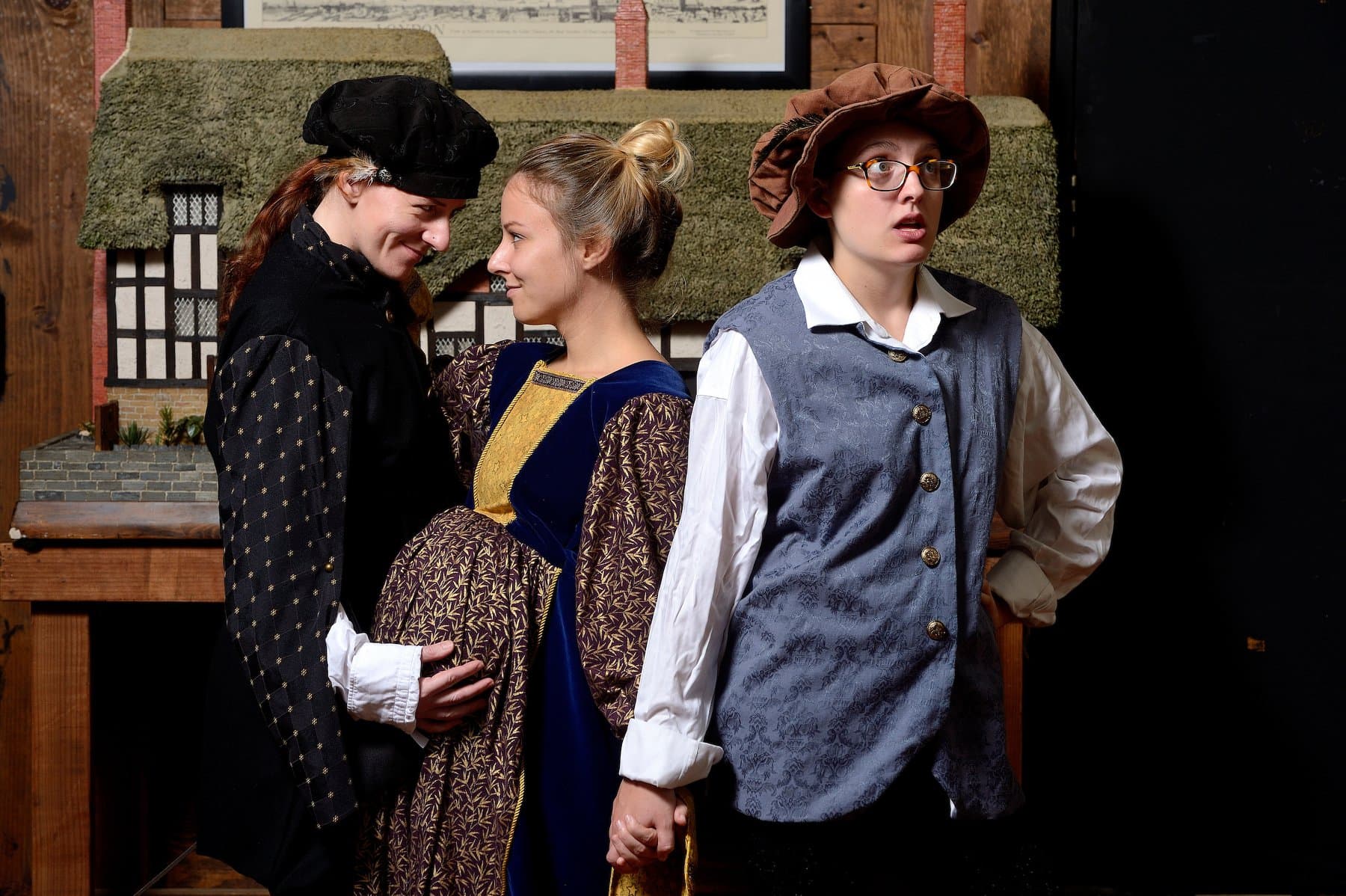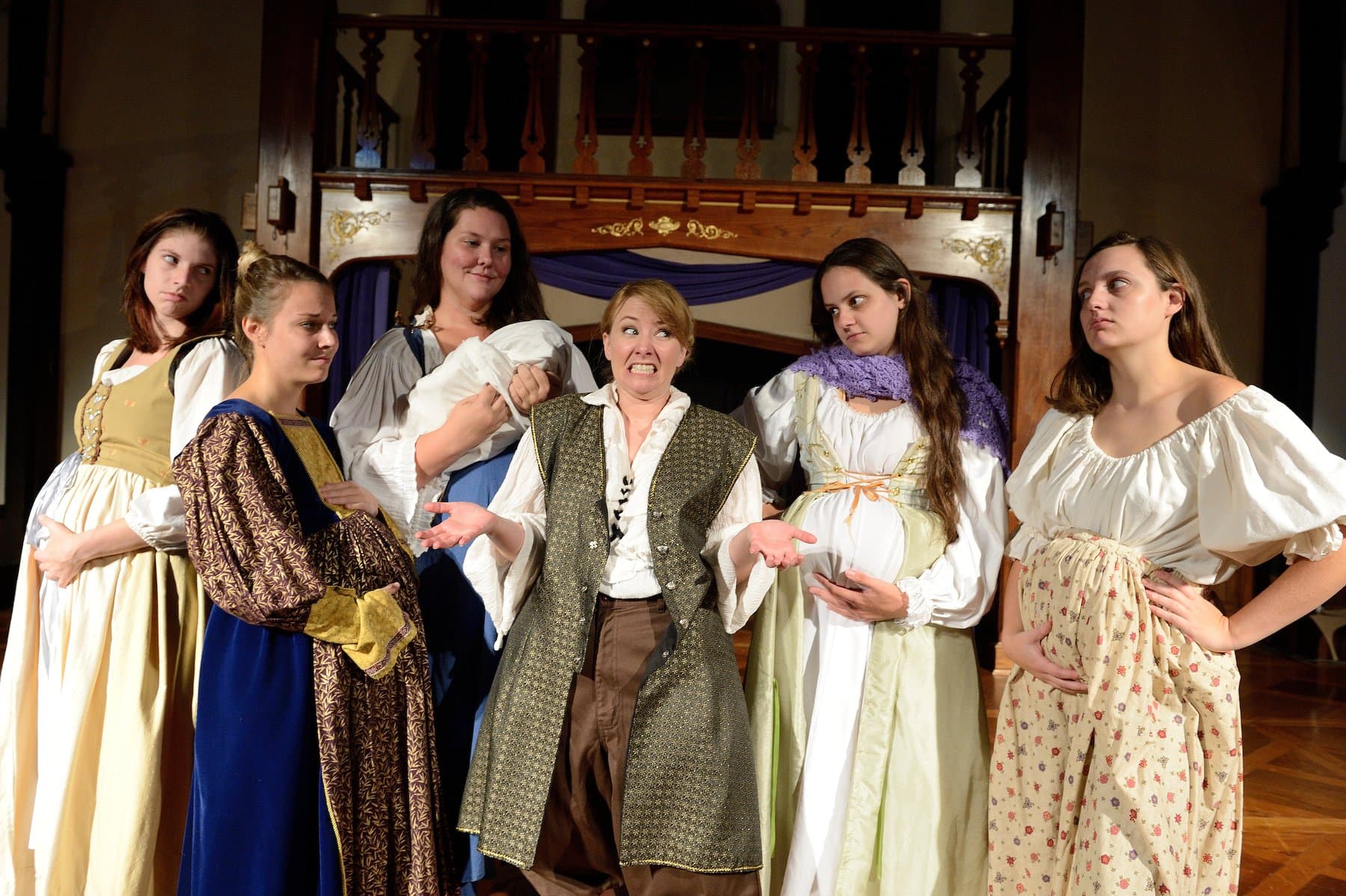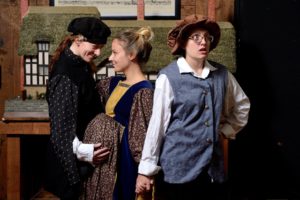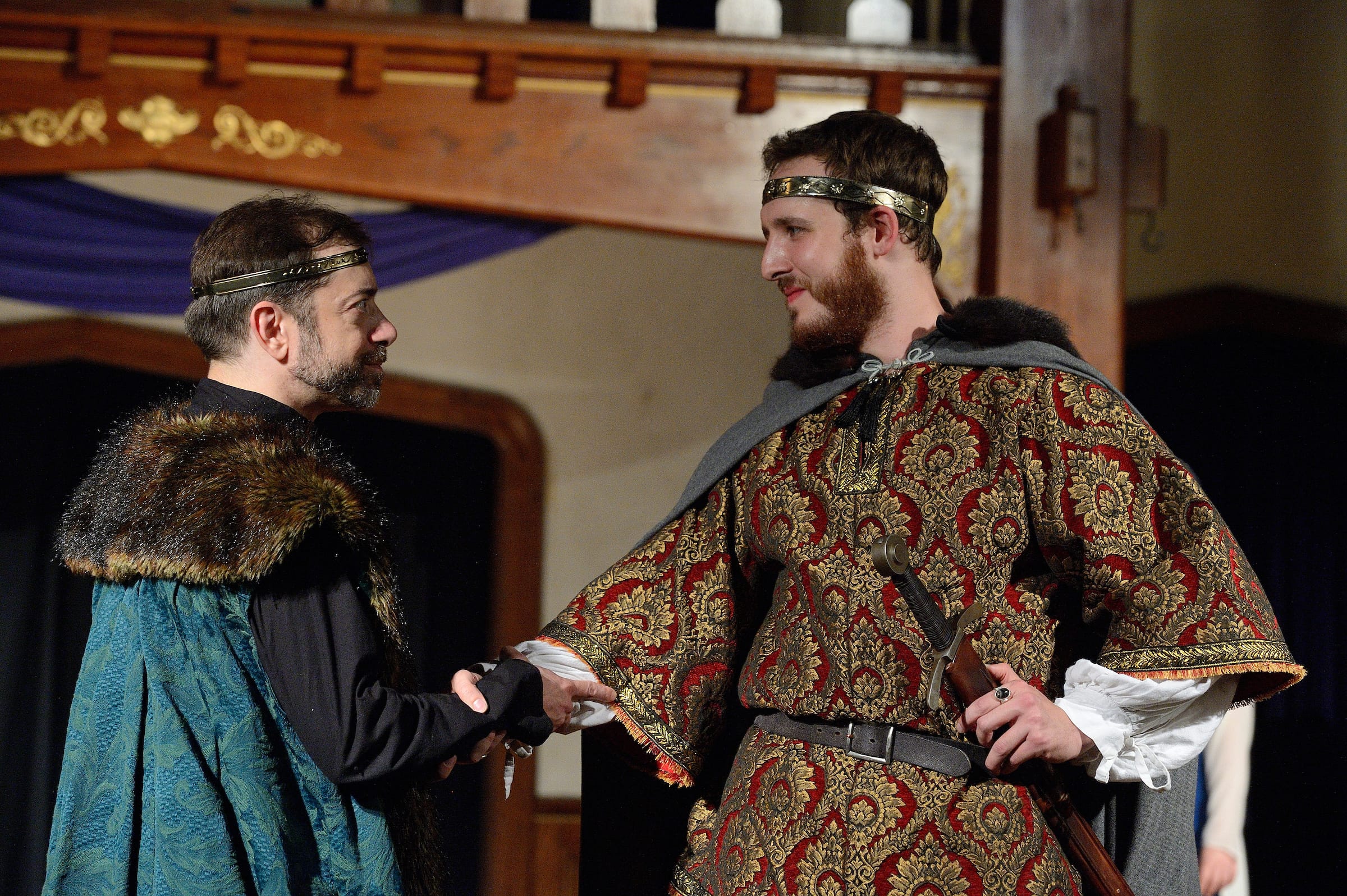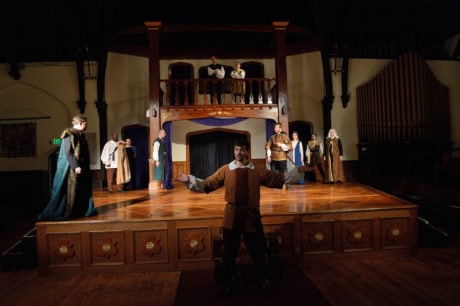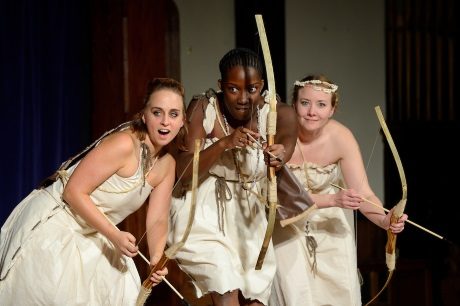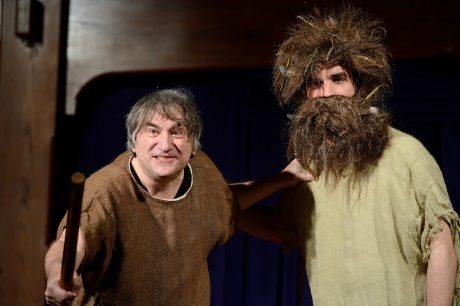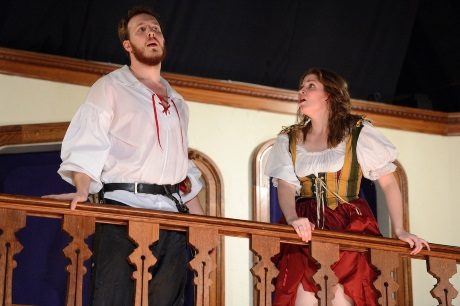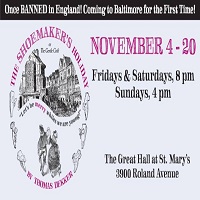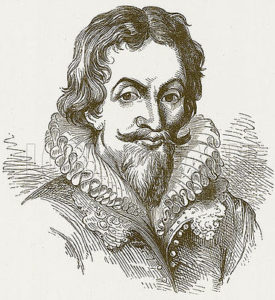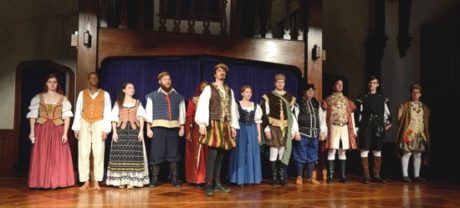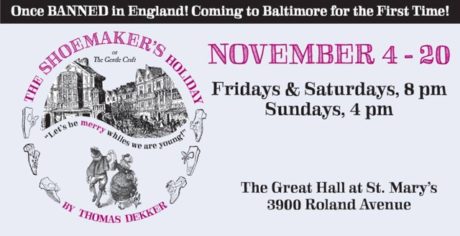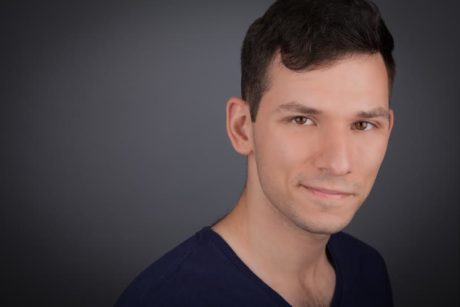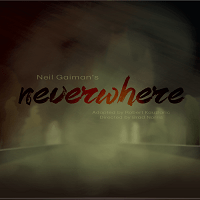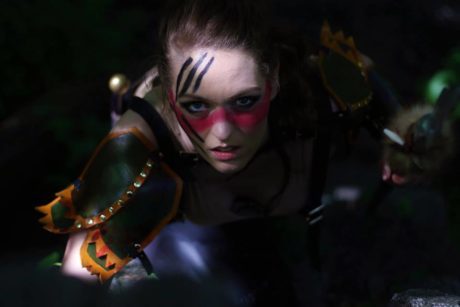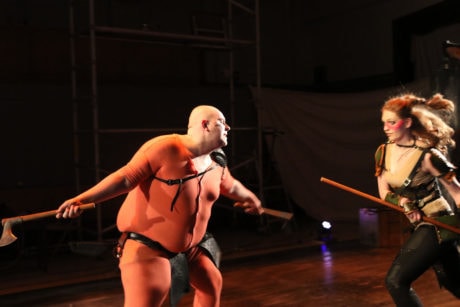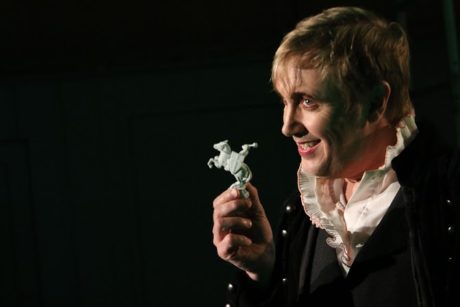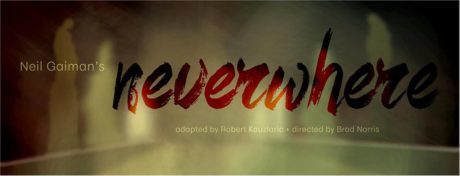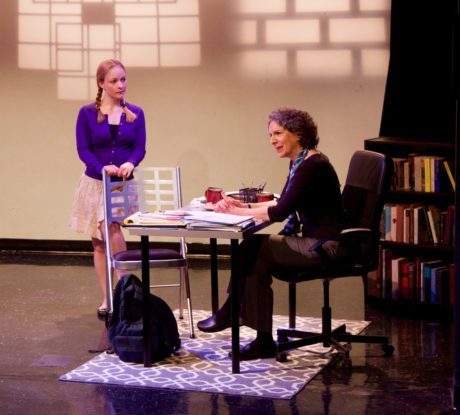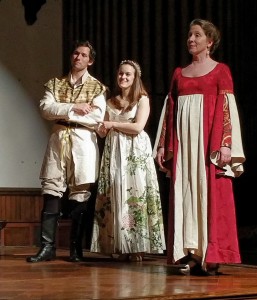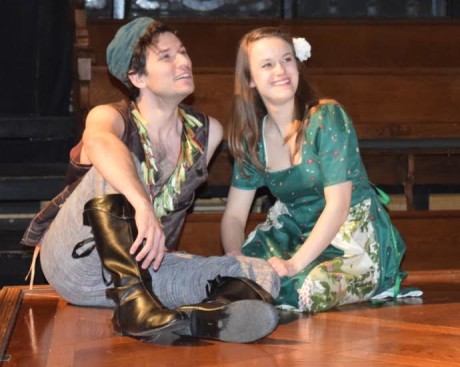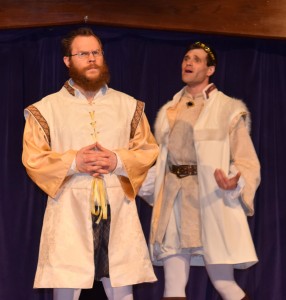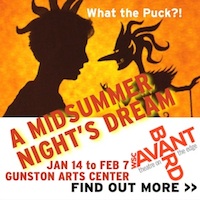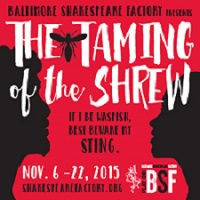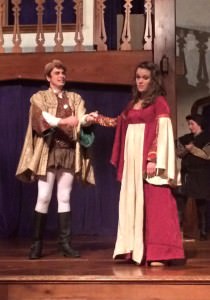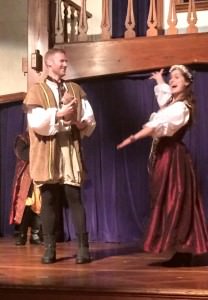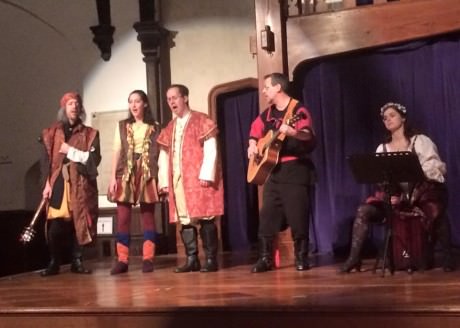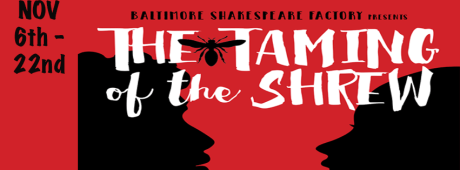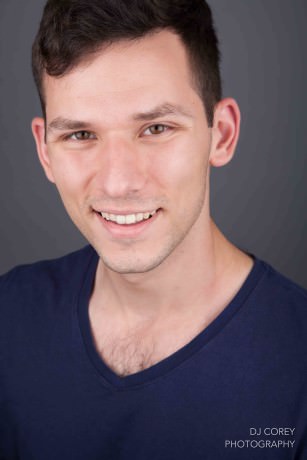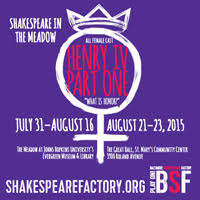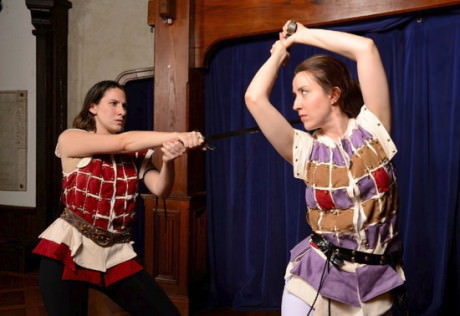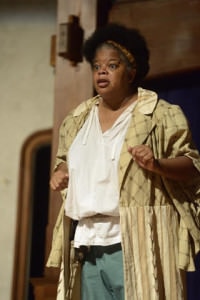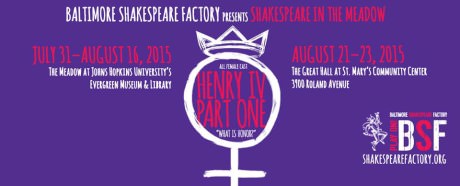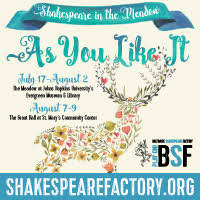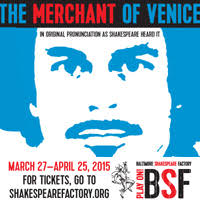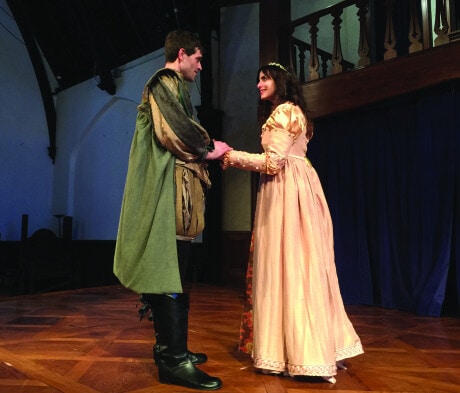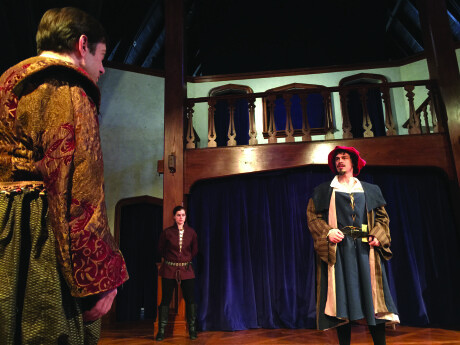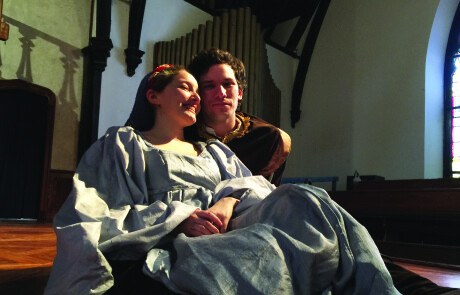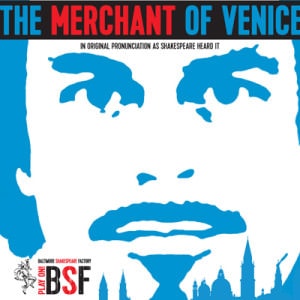
DCMetroTheaterArts’ Best of 2016 #14: Best Design in Professional and Community Theaters in DC/VA/MD Are:
John Alexander for his lighting for Blackberry Winter at Forum Theatre.
John Alexander for his lighting for Black Nativity at Theater Alliance.
Brian Allard for his lighting for Sleeping Beauty at Synetic Theater.
Clint Allen for his projections for Angels in America Part 1: Millennium Approaches: a joint Production of Round House Theatre and Olney Theatre Center.
Clint Allen for his projections for Angels in America Part 2: Perestroika: a joint Production of Round House Theatre and Olney Theatre Center.
Jeffery Scott Auerbach for his lighting for Nice Work if You Can Get It at The Arlington Players.
Christopher Baine for his sound for Girl in the Red Corner at The Welders.
Christopher Baine for his sound for Satchmo at the Waldorf at Mosaic Theater Company of DC.
Mike Baldassari for his lighting for The Secret Garden at Shakespeare Theatre Company.
Kat Beem for her costumes for Much Ado About Nothing at Silver Spring Stage.
Jesse Belsk for his lighting for Sense and Sensibility at Folger Theatre.
Colin K. Bills for his lighting for Collective Rage: A Play in Five Boops at Woolly Mammoth Theatre Company.
Colin Bills for his lighting for The Nether at Woolly Mammoth Theatre Company.
Jeane Binney for her costumes for Lost in Yonkers at Prince George’s Little Theatre.
Aaron Bliden for his score for Hugo Ball: a Dada puppet AdveNTuRe!!/?1!!?? at Pointless Theatre Company.
Mary Bova and A.T. Jones Costumers for their costumes for The Lion in Winter at Vagabond Players.
Chuck Bowden for his lighting for Mary Poppins at Phoenix Festival Theater at Harford Community College.
Alex Brady for his lighting for Who’s Afraid of Virginia Woolf at The Colonial Players of Annapolis.
Donna Breslin for her costumes for Goyescas at The In Series.
Michael Carnahan for his set for Les Liaisons Dangereuses at Center Stage.
Andrew R. Cissna for his lighting for Cat on a Hot Tin Roof at Round House Theatre.
Andrew R. Cissna for his set for Promised Land at Mosaic Theater Company of DC.
Madeline Clamp for her sound for What We’re Up Against at The Keegan Theatre.
Jeff Clausen for his sound for Cabaret at Kensington Arts Theatre.
Josh Clayton for his orchestrations for Titanic The Musical at Signature Theatre.
Alexandra Kelly Colburn for her projections for Kiss at Woolly Mammoth Theatre Company.
Franklin Coleman for his lighting design for West Side Story at The Little Theatre of Alexandria.
Joshua Coyne for his music direction for Titanic The Musical at The Theatre Lab School of the Dramatic Arts.
Robert Croghan for his costumes for Who’s The Boss? at The In Series.
Ken and Patti Crowley for their lighting for Gypsy at Reston Community Players.
Ken and Patti Crowley for their lighting for Master Class at Reston Community Players.
Ken and Patti Crowley for their lighting for The History Boys at The Little Theatre of Alexandria.
Ben Cunis and Vato Tsikurishvili for their fight and sword choreography for The Man in the Iron Mask at Synetic Theater.
Patrick David for his set design for Amadeus at Providence Players of Fairfax.
Jared Davis for his set for Man of La Mancha at The Arlington Players.
Dan Deiter for his sound for Black Nativity at Theater Alliance.
Paul Tate Depoo III for his set for Titanic The Musical at Signature Theatre.
Brittany Diliberto for her lighting for The Man in the Iron Mask at Synetic Theater.
Max Doolittle for his lighting for Kiss at Woolly Mammoth Theatre Company.
Brian Douglas, Mary Wakefield, and Sascha Nelson for Man of La Mancha at Laurel Mill Playhouse.
Kathy Dunlap for her costumes for Gypsy at Reston Community Players.
Cassandra Dutt for her set for Schoolgirl Figure at Cohesion Theatre Company.
Laura J. Eckelman for her lighting for Girl in the Red Corner at The Welders.
Parker Esse for his choreography for Carousel at Arena Stage.
Daniel Ettinger for his set design for Mary Poppins at Olney Theatre Center.
Richard Farella for his sound for Deathtrap at The Arlington Players.
William T. Fleming for his set for Humble Boy at Silver Spring Stage.
James Fouchard for his set for Dot at Everyman Theatre.
Rick Fox for his musical direction for The Secret Garden at Shakespeare Theatre Company.
Kristina Friedgen for her choreography for The Drowsy Chaperone at Damascus Theatre Company.
James Bigbee Garver for his musical direction for A Midsummer Night’s Dream at WSC Avant Bard.
James Bigbee Garver for his sound for Kiss at Woolly Mammoth Theatre Company.
Chip Gertzog for his lighting and projection design for Almost Maine at Providence Players of Fairfax.
Brian Gillick for his set for Black Nativity at Theater Alliance.
Hillary Glass for her costumes for Foxfire at Bowie Community Theatre.
Andrew Gordon for his choreography for Guys and Dolls.
A.J. Guban for his set for Equus at Constellation Theatre Company.
A.J. Guban for his set and lighting for Urinetown at Constellation Theatre Company.
Jason Hamrick for his sound for Amadeus at Providence Players of Fairfax.
Palmer Hefferan for her sound for Equus at Constellation Theatre Company.
Bart Healy for his set for Gypsy at Reston Community Players.
Andrea Heininge for her choreography for Gypsy at Reston Community Players.
Andrea Heininge for her choreography for Mary Poppins at Reston Community Players.
Joshua Horvath for his sound for Angels in America Part 1: Millennium Approaches: a joint Production of Round House Theatre and Olney Theatre Center.
Joshua Horvath for his sound for Angels in America Part 2: Perestroika: a joint Production of Round House Theatre and Olney Theatre Center.
Ann Hould-Ward for her costumes for The Secret Garden at Shakespeare Theatre Company.
Kelsey Hunt for her costumes for Collective Rage: A Play in Five Boops at Woolly Mammoth Theatre Company.
Kelsey Hunt for her costumes for The Nether at Woolly Mammoth Theatre Company.
Garrett Hyde for his sound for H.M.S. Pinafore at 2nd Star Productions.
Allison Samantha Johnson for her costumes for What We’re Up Against at The Keegan Theatre.
Lynn Joslin for her lighting for Monsters of the Villa Diodati at Creative Cauldron.
Misha Kachman for his set and costumes for Kiss at Woolly Mammoth Theatre Company.
Casey Kaleba for his fight choreography for The Lonesome West at The Keegan Theatre.
Casey Kaleba for his fight choreography for The Maid’s Tragedy at Brave Spirits Theatre.
Kathryn Kawecki for her set for Anne of the Thousand Days at Chesapeake Shakespeare Company.
Kathryn Kawecki for her set for Lobby Hero at 1st Stage.
Mary Keegan for her lighting for Lobby Hero at 1st Stage.
Matthew Keenan for his set design for American Idiot at The Keegan Theatre.
Matthew Keenan for his set for Next to Normal at The Keegan Theatre.
Matthew Keenan for his set for What We’re Up Against at The Keegan Theatre.
York Kennedy for his lighting for Angels in America Part 1: Millennium Approaches: a joint Production of Round House Theatre and Olney Theatre Center.
York Kennedy for lighting for Angels in America Part 2: Perestroika: a joint Production of Round House Theatre and Olney Theatre Center.
Illona Kessell for her choreography for Urinetown at Constellation Theatre Company.
Hana Sooyeon Kim for her set and projections for The Emperor’s Nightingale at Adventure Theatre.
Daniel Kluger for his score for Collective Rage: A Play in Five Boops at Woolly Mammoth Theatre Company.
Adam Koch for his set for My Fair Lady at Riverside Center for the Performing Arts.
James Kronzer for his set for Angels in America Part 1: Millennium Approaches: a joint Production of Round House Theatre and Olney Theatre Center.
James Kronzer for his set for Angels in America Part 2: Perestroika: a joint Production of Round House Theatre and Olney Theatre Center.
Frank Labovitz for his costumes for Titanic The Musical at Signature Theatre.
Gaye Law for her costumes for Oklahoma! at Riverside Center for the Performing Arts.
Dan Laffrey for his set for Collective Rage: A Play in Five Boops at Woolly Mammoth Theatre Company.
Grant Kevin Lane for his costumes for Nice Work if You Can Get It at The Arlington Players.
Gaye Law and Jim Halliday for their costumes for My Fair Lady at Riverside Center for the Performing Arts.
Dan Patrick Leano for his lighting for Cabaret at Kensington Arts Theatre.
Maria Littlefield for her props for The Drowsy Chaperone at Damascus Theatre Company.
Patrick Lord for his projections for American Idiot at The Keegan Theatre.
Anna Louizos for her set for The Secret Garden at Shakespeare Theatre Company.
Konstantine Lortkipanidze for his score for Sleeping Beauty at Synetic Theater.
Eric Lund and Alex Brady for their lighting for Venus in Fur at The Colonial Players of Annapolis.
Timothy R. Mackabee for his set for The Roommate at Everyman Theatre.
Andrew Malone for his costumes and wigs for Evita at Spotlighters Theatre.
Andrew Malone for his costumes for The Game’s Afoot at Spotlighters Theatre.
Charlotte Marson and Judy Whelihan for their costumes for Mary Poppins at Reston Community Players.
Brandee Mathies for her costumes for Black Nativity at Theater Alliance.
Walter “Bobby” McCoy for his musical direction for My Fair Lady at Riverside Center for the Performing Arts.
John McDermott for his set for Sense and Sensibility at Folger Theatre.
Elizabeth McFadden for her set for Fidelio at The In Series.
Neil McFadden for his sound for Lobby Hero at 1st Stage.
Paige Rammelkamp for her musical direction for Man of La Mancha at The Arlington Players.
Jared Mezzocchi for his projections for The Nether at Woolly Mammoth Theatre Company.
Kel Millionie for his set for Neverwhere at Cohesion Theatre Company.
Kel Millionie for his set and lighting for The Elephant Man at Fells Point Corner Theatre and Collaborative Theatre Company.
Matthew Mills for his sound for Shrek The Musical at Rockville Musical Theatre.
Mark Minnick for his choreography for Sister Act at Toby’s The Dinner Theatre of Columbia.
Mark Minnick for his choreography for Hairspray at Toby’s The Dinner Theatre of Columbia.
Drew Moberley for his sound for Nice Work if You Can Get It at The Arlington Players.
John K. Monnett for his choreography for Nice Work if You Can Get It at The Arlington Players.
Andrea Moore for her set and props for Heroes & Monsters at Flying V Theatre.
Andrea Moore for her puppets and properties for The Emperor’s Nightingale at Adventure Theatre.
David M. Moretti for his set for The Boys in the Band at Dominion Stage.
James Moore for his musical directing and conducting for Titanic The Musical at Signature Theatre.
David Moretti for his set for ‘night, Mother at Dominion Stage.
Conor Mulligan for his lighting for The Other Place at Rep Stage.
Stephanie Mumford for her set for The Lady With the Little Dog at Quotidian Theatre Company.
Lawrence Munsey and Mary Quinn for their costumes for Hairspray at Toby’s The Dinner Theatre of Columbia.
Lawrence Munsey and Mary Quinn for their costumes for Sister Act at Toby’s The Dinner Theatre of Columbia.
Sasha Nelson, Cynthia Anderson, Lisa Oberg, and Kat McKerrow for their costumes for Man of La Mancha at Laurel Mill Playhouse.
Stowe Nelson for his sound for The Roommate at Everyman Theatre.
Gordon Nimmo-Smith for his sound for Be Awesome: A Theatrical Mixtape of the 90s at Flying V.
Brad Norris for his sound for Neverwhere at Cohesion Theatre Company.
Jake Null for his musical direction for American Idiot at The Keegan Theatre.
Jake Null for his musical direction for Next to Normal at The Keegan Theatre.
Jake Null for Urinetown at Constellation Theatre Company.
Jake Null for The Who’s Tommy at Open Circle Theatre.
Daniel O’Brien for his set for Othello at Chesapeake Shakespeare Company.
Matthew Pauli for his puppet design for Mary Poppins at Olney Theatre Center.
Daniel Pinha for his set for The Man in the Iron Mask at Synetic Theater.
Meghan Raham for her set for Cat on a Hot Tin Roof at Round House Theatre.
Beth Ratrie and Rosalyn Kooser for their costumes for Ragtime at The Memorial Players.
Joshua Redford for his sound for Gypsy at Reston Community Players.
Andrew JM Regiec for his set for Deathtrap at The Arlington Players.
Matthew Richards for his lighting for Les Liaisons Dangereuses at Center Stage.
David Rohde for his musical direction for Oklahoma! at Riverside Center for the Performing Arts.
Ryan Ronan for his set for Foxfire at Bowie Community Theatre.
Jonathan Ezra Rubin for his fight choreography for Be Awesome: A Theatrical Mixtape of the 90s at Flying V.
Jonathan Ezra Rubin for his fight choreography for Neverwhere at Cohesion Theatre Company.
Diane Samuelson on the cello and Jon Jon Johnson on the violin for their playing in Be Awesome: A Theatrical Mixtape of the 90s at Flying V.
Joel Selzer for his set and lighting for Avenue Q at Vagabond Players.
Loren Shaw for her costumes for The Taming of The Shrew at Shakespeare Theatre Company.
Brittany Shemuga for her lighting and projections for Rameau’s Nephew at Spooky Action Theatre.
Jason Sherwood for his set for The Taming of The Shrew at Shakespeare Theatre Company.
Eric Shimelonis for The Nether at Woolly Mammoth Theatre Company.
Stefan Sittig for his choreography for West Side Story at The Little Theatre of Alexandria.
Deb Sivigny for her costumes for The Emperor’s Nightingale at Adventure Theatre.
Deb Sivigny for her set for Girl in the Red Corner at The Welders.
Don Slater for his lighting for The Lady With the Little Dog at Quotidian Theatre Company.
Terri Slivka for his props for The Boys in the Band at Dominion Stage.
Mark Smedley for his sound for Sister Act at Toby’s The Dinner Theatre of Columbia.
Robbie Snow for her costumes for Amadeus at Providence Players of Fairfax.
Thomas Sowers for his sound for Blackberry Winter at Forum Theatre.
Thomas Sowers for his sound for Collective Rage: A Play in Five Boops at Woolly Mammoth Theatre Company.
Thomas Sowers for his sound for The Man in the Iron Mask at Synetic Theater.
Paul Sportelli for his musical direction for Carousel at Arena Stage.
Timothy Splain for his musical direction for Mary Poppins at Olney Theatre Center.
Ivania Stack for her costumes for Angels in America Part 1: Millennium Approaches: a joint Production of Round House Theatre and Olney Theatre Center.
Ivania Stack for her costumes for Angels in America Part 2: Perestroika: a joint Production of Round House Theatre and Olney Theatre Center.
Ivania Stack for her costumes for King Ubu at Pointless Theatre Company.
Alice Stanley for her sound for Hamlet at Cohesion Theatre Company.
Scott Stark for his props for Nice Work if You Can Get It at The Arlington Players.
Luciana Stecconi for her set for When the Rain Stops Falling at 1st Stage.
Roy Steinman and Moe Conn for their set for The Lion in Winter at Vagabond Players.
Linda Swann for her costumes for Guys and Dolls at 2nd Star Productions.
Erik Teague for his costumes for Equus at Constellation Theatre Company.
Erik Teague for his costumes for Girl in the Red Corner at The Welders.
Eric Teague for his costumes for The Man in the Iron Mask at Synetic Theater.
Kristen Thompson for her lighting for Heroes & Monsters at Flying V Theatre.
Justin Thilman for his lighting for Les Liaisons Dangereuses at Audrey Herman’s Spotlighters Theatre.
Giorgos Tsappas for his set for Rameau’s Nephew at Spooky Action Theatre.
Irina Tsikurishvili for her choreography for Sleeping Beauty at Synetic Theater.
Ryan Tumulty for his choreography for Be Awesome: A Theatrical Mixtape of the 90s at Flying V.
Tara Jeanne Vallee for her choreography for Mary Poppins at Olney Theatre Center.
Septime Webre and David Palmer for their choreography for Bizet’s Carmen in Havana at The In Series.
Allan Sean Weeks for his lighting for American Idiot at The Keegan Theatre.
Allan Sean Weeks for his lighting for Next to Normal at The Keegan Theatre.
Allan Sean Weeks for his lighting for What We’re Up Against at The Keegan Theatre.
Sibyl Wickersheimer for her set for The Nether at Woolly Mammoth Theatre Company.
Tegan Williams and Brad Norris for their fight choreography for The Complete Deaths of William Shakespeare at Cohesion Theatre Company and Baltimore Shakespeare Factory.
Joanne Wilson for his props for H.M.S. Pinafore at 2nd Star Productions.
Michael Winch for his sound for Hugo Ball: a Dada puppet AdveNTuRe!!/?1!!?? at Pointless Theatre Company.
Jane Wingard for her set for Guys and Dolls at 2nd Star Productions.
Jane Wingard for her set for H.M.S. Pinafore at 2nd Star Productions.
Alan Wray for his sound design for To Kill a Mockingbird at The Little Theatre of Alexandria.
Alan Zemla for his set for The Game’s Afoot at Spotlighters Theatre.
Amanda Zieve for her lighting for Titanic The Musical at Signature Theatre.
HOW WE SELECTED OUR HONOREES
DCMetroTheaterArts writers were permitted to honor productions and concerts, dance, and operas that they saw and reviewed and productions and concerts and dance performances that they saw but did not review. Every honoree was seen. These are not nominations. There is no voting.
The staff is honoring productions, performances, direction, and design in professional, community, university, high school, and children’s theatres, and are also honoring the same in musical venues. We are honoring work in Washington, DC, Maryland, Virginia, Philadelphia, PA, New Jersey, and Delaware.
LINKS:
DCMetroTheaterArts’ Best of 2016 #1: Best Musicals in Professional Theaters in DC/MD/VA.
DCMetroTheaterArts’ Best of 2016 #2: Best Musicals In Community Theaters in DC/MD/VA.
DCMetroTheaterArts’ Best of 2016 #7: Best Performances and Ensembles in Musicals in Professional Theaters in DC/MD/VA.
DCMetroTheaterArts’ Best of 2016 #8: Best Performances in Musicals in Community Theaters in DC/MD/VA.
DCMetroTheaterArts’ Best of 2016 #9: Best Performances and Ensembles in Plays in Professional Theaters in DC/MD/VA.
DCMetroTheaterArts’ Best of 2016 #10: Best Direction in Musicals in Professional Theatres in DC/MD/VA.
DCMetroTheaterArts’ Best of 2016 #11: Best Performances and Ensembles in Plays and Musicals in Philadelphia, New York, Delaware, and New Jersey.
DCMetroTheaterArts’ Best of 2016 #12: Best Direction of Plays in Professional Theater in DC/MD/VA.
DCMetroTheaterArts’ Best of 2016 #13: Best Direction in Musicals and Plays in Community Theatres in DC/MD/VA.
DCMetroTheaterArts’ Best of 2016 #14: Best Design in Professional and Community Theaters in DC/VA/MD.
The Complete List of The ‘Best of 2015’ Honorees on DCMetroTheaterArts.
